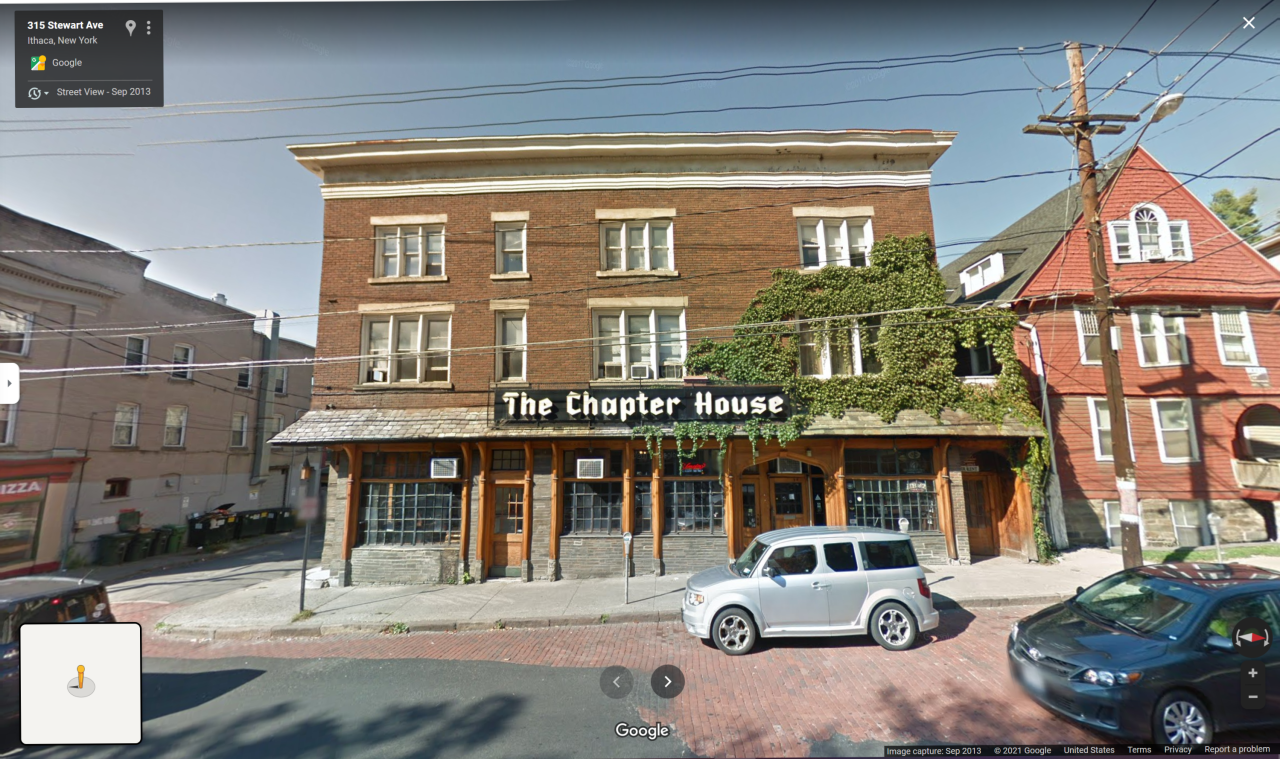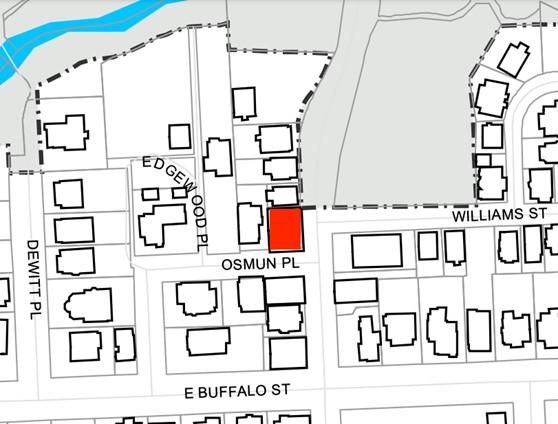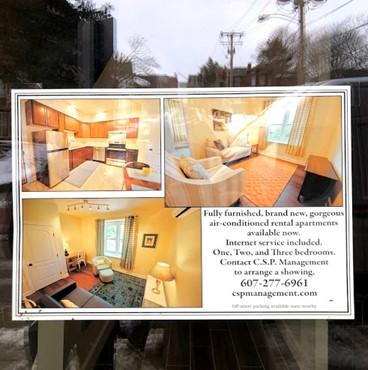
400 Stewart is a three-story mixed-use building on the corner of Stewart Ave and Osmun Place in Ithaca’s East Hill Historic District, two blocks west of Collegetown. For well over a century, the building was home to mom and pop shops and quintessential student watering holes. Built in 1898, it started as a series of shops to serve the growing university community -a tailor, a tobacco shop, pool hall, and a confectionary. By the late 1920s, at the height of Prohibition, it became a tavern known as Jim’s Place (Hayes, 2015). In the 1960s Jim’s Place became the Chapter House --an iconic college beer joint, beloved by generations of students and Ithacans alike (Hayes, 2015). The Chapter House remained a favorite haunt until April 14, 2015, when it and the adjacent building, 406 Stewart, burned in a fire. After sitting vacant for three years, it was rebuilt in 2018 based on its original features.

Although the damage was significant, the buildings did not burn all the way to the ground (see figures 4 and 5). “We had hoped for re-use of some of the building, but the reports indicated it was too far gone” (Dietz, 2015). Because of its historic designation, the demolition had to be approved by the ILPC as stipulated under section 228-3 of the city’s municipal code. On January 16, 2016, the Ithaca Landmarks Preservation Commission approved the design for the new building, finding its details and materials compatible with the historic character of the East Hill Historic District. In particular, they liked that the design harked back to the original building, with its brick and stone cladding, storefront windows, and mansard roof (ILPC, 2016), but did not try to imitate the original. “The amalgamation of architectural styles... contemporary and traditional building materials, and modern building techniques will identify it as a new structure within the Historic District” (ILPC, Jan 2016).
Just four months after ILPC approved construction, the owner, Sebastian Mascaro, abruptly sold the empty lot to James L. Goldman, the owner of 406 Stewart, for $850,000. Goldman owns a private airport in New Hampshire and two other parcels on Stewart and Osmun Place, which he bought from Mascaro. Under new ownership, the project architect, Jason Demarest, sought approval to remove the mansard roof from the north side of the building, for fire-safety compliance, and to use “brick block” on that side (concrete scored and colored to look like brick) to bring costs down. The ILPC approved the removal of the north-facing mansard roof but denied the request to use brick block, citing that it would have a “substantial adverse effect on the aesthetic, historical, or architectural significance” (ILPC, March 2016) of the East Hill District. Today 400 and 406 Stewart are joined on the second floor but the apartments are unoccupied.

The building is zoned B2-d for Business/Commercial use, with residential units above, though the entire building is still vacant (Tompkins County; n.d.; Urban Footprint; ILPC, 2016). B-2d zoning allows for a maximum height of 4 stories or 40 feet, and 75% lot coverage. The property is zoned for “medium-density residential” on the City’s Future Land Use Map -- an area averaging between 10 and 20 dwelling units per acre and containing a diverse mix of housing typologies (City of Ithaca Future Land Use Map, 2015). Since the property is in the East Hill Historic District, it is subject to Ithaca Landmarks Preservation Commission guidelines and regulations. “The hope was to have the iconic grad student dive reopen by the 2016-2017 academic year” (Brokaw, 2016). Today the developer still has the 3,000 square foot-commercial ground floor space as “ideal for a restaurant/bar”, but there are no current plans to bring back the Chapter House name (Annbinder, 2018), even though the Chapter House license-holder, John Hoey, has expressed a strong interest in reopening the tavern (Brokaw, 2016). The ground floor space is listed at a pricey $35/square foot, about twice as much as the average downtown space.

400 Stewart is part of the Local and National Historic District of East Hill (City of Ithaca, 2017), an area containing the highest concentration of Ithaca’s architecturally and historically significant buildings built between 1870-1920. Any zoning variance or architectural change in this area must be approved by the Ithaca Landmarks Preservation Commission (ILPC). East Hill displays many architectural styles that were popular in America at the turn of the 20th century, including Greek Revival, Italianate, Queen Anne, Renaissance Revival, and Arts and Crafts. The homes are set into the steep hill that rises up to meet Cornell - they are sprawling, some ornate, with deep setbacks and tended front yards. Most have been divided up into multiple units and shared student housing. The area is dense with students on their way to or from school.
In this residential context, 400 Stewart and its neighbor to the south, 310 Stewart, are the only two buildings on the block with big storefront windows, so it's clear they were built as retail spaces to serve their rural/residential surroundings and the burgeoning university population. The Carriage House Cafe, another popular student haunt until it closed recently, sits just across the street, and so does the Cornell student radio station, WVBR. From a pedestrian experience, these mixed-use buildings “talk to each other” in a sense, signaling increased foot traffic and commercial activity. This particular stretch of Stewart Ave, between Buffalo and Cascadilla, is wider than the residential blocks to the north and south, and patches of street asphalt give way to uneven, exposed brick, giving it a historic flavor.

The fact that the building is still vacant three years after completion raises some questions. Why, especially in this economic downturn, and after investing so much in the rebuild, would the owner still let the place sit empty? Requests for comment from the Ithaca Voice and Cornell Sun have been repeatedly denied; phone calls and emails have gone unanswered (Brokaw, 2016). Given the expensive listing price, and the precariousness of the restaurant industry in the pandemic, the owner could be waiting for a high-paying renter with bigger profit margins than a tavern, such as a bank or a more “financially-stable” retail. I peeked through the window and saw a drab, charmless, institutional-looking stairwell and cheap carpeting. It reminded me that the ILPC only has control over historic building exteriors and none at all over the interior design and use. Whatever the future use, I sincerely hope the future storefront occupant of 400 Stewart builds community the way the Chapter House did.
- Anjali Fisher
Sources
-
Annbinder, M. (2018, April 14). Three years after the fire, building nears completion where Chapter House stood. 14850.com. Retrieved from: https://www.14850.com/04146644-chapter-house-1804/
-
Brokaw, J. (2016, April 26). Future of New Chapter House in Doubt. Ithaca.com. Retrieved from: https://www.ithaca.com/news/future-of-new-chapter-house-in-doubt/article_20b7ab6e-0b66-11e6-a6ef-af5b36680054.html
-
Burbank, D. (2015, April 15). Cause of Chapter House fire not declared; avoid area. Ithaca Voice. Retrieved from: https://ithacavoice.com/2015/04/cause-chapter-house-fire-not-declared-avoid-area/
-
Hayes, M. (2015, April 14). Chapter House Remembered. Ithaca Journal. Retrieved from: https://www.ithacajournal.com/story/news/local/2015/04/14/chapter-house-history/25772475/
-
City of Ithaca. N.d. East Hill Historic District Map. Retrieved from: https://www.cityofithaca.org/DocumentCenter/View/1594/East-Hill-Historic-District-Map?bidId=
-
City of Ithaca. (2017, January). Historic Districts, Ithaca, NY. Retrieved from: https://www.cityofithaca.org/DocumentCenter/View/1430/Historic-Districts-PDF?bidId=
-
City of Ithaca. (2018). Official Zoning Map of the City of Ithaca, New York. Retrieved from: http://www.cityofithaca.org/DocumentCenter/View/1436/City-of-Ithaca-Official-Zoning-Map-PDF?bidId=
-
City of Ithaca. (2020, July 1). City of Ithaca Tax Map. Retrieved from: https://property.tompkins-co.org/IMO/quickstream.aspx?file=PDFMAPS/500700/063000.pdf
-
City of Ithaca. (2020, Dec 10). Local Historic Properties. Retrieved from: https://www.cityofithaca.org/DocumentCenter/View/1584/Locally-Designated-Historic-Properties-by-Address-PDF
-
Ithaca Future Land Use Map (2015, June 15). Retrieved from: http://www.cityofithaca.org/DocumentCenter/View/2707/Draft-Future-Land-Use-Map-61615?bidId=
-
ILPC. (2016, Jan 20). Meeting Minutes. Retrieved from: https://lfweb.tompkins-co.org/WebLink/DocView.aspx?id=532304&dbid=13&repo=CityOfIthaca
-
ILPC. (2016, March 8). Meeting Minutes. Retrieved from: https://lfweb.tompkins-co.org/WebLink/DocView.aspx?id=562337&dbid=13&repo=CityOfIthaca
-
Mike Blaney. (2017, June). “Ithacating in Cornell Heights.” Retrieved from: https://ithacating.com/2017/06/16/chapter-house-406-stewart-avenue-construction-update-62017/
-
Tompkins County. n.d. Tompkins County Property Viewer. Retrieved from: https://geo2.tompkins-co.org/html/?viewer=tcpropmo


